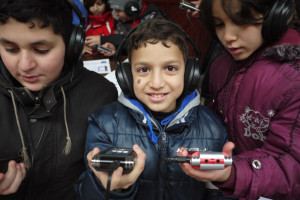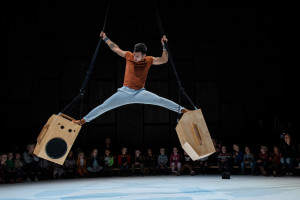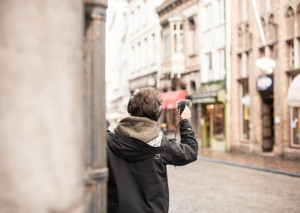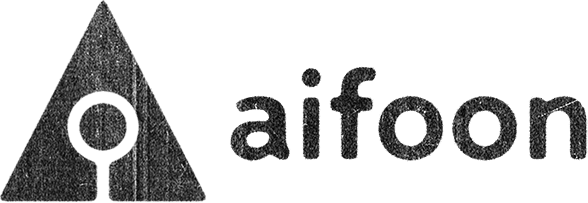Listen, the bell pepper is sprouting
aifoon: elevating listening to an art form since 2005
Sound may be all around us, but we hardly ever give this fascinating world of vibrations our full attention. For fifteen years now, aifoon has been raising our awareness of the wealth of sounds that surrounds us and the imaginative world beyond reality where sound becomes poetry.
For Stijn Dickel, initiator and artistic director of aifoon, ‘better listening’ was not merely an artistic challenge, it was a medical imperative. Dickel is hypersensitive to sound, which means all sounds have an equal impact on him: the music on the radio, the creaking of the stairs, the jangling of the cutlery draw ...
For him, the challenge was to reduce his listening spectrum, to focus on certain sounds and shut out the rest. Ironically enough, today Dickel advocates precisely the opposite approach.
aifoon invites you to listen better, more broadly, differently. To see the world differently.

aifoon’s artistic research is concerned with the expansion of the listening experience: listening better, more broadly, differently. To see the world, well, differently. Dickel: “Sound has a massive effect on us; it influences our lives in ways both conscious and subconscious. Those who are prepared to listen more attentively can expect to discover immense beauty in our sonic landscape.”
With the goal of promoting a richer listening culture, over the past fifteen years aifoon has created numerous exhibitions, installations and publications, bringing its work to classrooms, prisons and the public space.
Dickel soon discovered that, with sound being so ubiquitous in society, the scope of the sound artist’s work is enormous. And, indeed, aifoon’s artistic history reads like a never-ending quest, albeit one limited by certain guiding principles.
It’s not so much about the aesthetic quality of sound – beautiful or ugly – as the impact of that sound on the listener and people collectively.
Listening is social.
Listening is social. “I love the sound of drilling, but I hate the poor acoustics of a canteen,” Dickel shares. An indication that aifoon is rarely concerned with the aesthetic qualities of sound – beautiful or ugly – but rather with the impact that sound has on people.
Listening is always embedded in a particular social context, after all. Take Phonorama Papegaaiwijk, for example, a multi-year project in Ghent’s Papegaai neighbourhood. Together with local residents and outsiders, aifoon attempted to visualise the neighbourhood’s ‘collective auditory experience’ over the course of five years. This was done by means of installations, concerts, field research and even a time capsule that hurled the area’s twenty most striking sounds into the future.
Listening is personal.
Everyone listens in their own unique way. For aifoon, the starting shot was its project De weg van huis naar school (‘the way from home to school’) in 2005, for which primary school pupils developed sonic portraits of the journey from their front doors to the school gates. Each child created a personal soundscape that was based just as much on their surroundings as it was on their own personal sensibility and body.
Dickel: “Listening doesn’t only concern the ears; it’s something you do with your whole body, from your head to your toes.” This early project provided the basis for aifoon’s DNA: listening as something social, physical, intellectual, emotional, philosophical and even artistic.
Listening doesn’t only concern the ears; it’s something you do with your whole body, from your head to your toes.”
Listening knows no boundaries.
Although aifoon’s artistic research unfolds in a participative way, it doesn’t have an explicit social objective. Dickel: “What we do is not centred on well-being but we do care about our impact on people. There’s no point in a sound installation that leaves people cold. In fact, in many cases we need the active input of our audience in order to do our research.”
This mutual exchange not only breaks down the boundaries between artist and audience, it also puts different audiences and even different cultures on an equal footing. For example, in 2019 two Syrian newcomers lent their ears to the Papegaai neighbourhood in Ghent, connecting their experience to that of the locals.
The innocent rumbling of a tram suddenly became the anxiety-inducing drone of a bombing raid. The awareness of these different listening perspectives unlocked a wealth of new interpretations.

Listening is physical.
aifoon turns sound art into listening art. This doesn’t place the focus on the sound designer, but rather on what the sound does. For aifoon, sound is an event that unfolds in time and space. In the circus production murmur (2019, a coproduction with theatre company Grensgeval), an acrobat enters into a duet with a spinning speaker and speakers that were hidden in the spectators’ backpacks.
A sound composition thus became a listening composition: the sound itself was dancing. Especially for this production, aifoon developed De Zwerm (‘the swarm’), a mobile and modular audio system that linked up the various speakers. De Zwerm will be further utilised as an artistic tool in the coming years.
Listening has no language.
There are few words to describe the experience of listening. Music is grouped into genres like jazz, folk or classical, while sound is hardly ever categorised.
Dickel: “Your fridge’s manual might tell you that ‘rrrr’ is normal, while ‘sshhht’ indicates a defect. Not very clear, eh?” The development of a language for sound is one of our main artistic focuses. For some time now, aifoon has been working together with the SMAK and two organisations for the blind in the development of a Sound Atlas that links sounds to objects or colours.
It is a project with a real, practical impact – an atlas such as this serves as a handy bridge in communications between visually impaired and sighted people – as well as a poetic aspect, in the way sound and colour are lovingly reconciled. Is this sound more orange or green?

Listening shapes the city.
In the coming years, aifoon seeks most of all to infiltrate the domain of architecture and urban planning. Dickel: “The city is getting busier and busier. You could ask for more silence, but you could just as well opt to improve its acoustics.”
Dickel wryly refers to Groen politician Filip Watteuw as ‘Ghent’s city composer’. Dickel: “As a result of his circulation plan for this city, we can once again hear the sound of a dog’s claws clattering on the pavement.” But while Watteeuw’s plan was inspired by pragmatism, Dickel takes it a step further...
Dickel: “We could further embellish this composition. Imagine if buses emitted a certain pitch on certain bus lanes, or if we used speakers to add the sound if chirping crickets to busy squares. Like sorcerers, we could add metaphorical dimension to the utilitarian world of urban planning.”
Listening is (an) art.
With these words, Dickel sketches aifoon’s ‘core business’: making people aware of the poetry that lies beyond the ostensibly banal, everyday world of sound.
“After a sound walk or a show, people often go home listening differently. This can be a magical experience: all of a sudden they can virtually hear the bell pepper seeds sprouting on their windowsill,” Dickel chuckles.
“The more that people open up to this auditory magic, the more beautiful the world will start to sound. That is perhaps the ultimate dream for aifoon.”
text: Evelyne Coussens
translation: Jonathan Beacon
